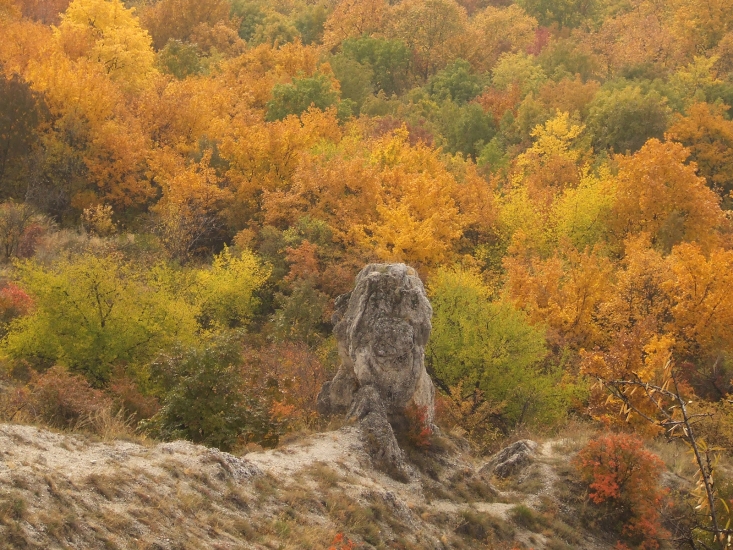"One of the most interesting communities in the Buda hills is found on the Eagle Hill, although from a distance it looks barren and rocky, with only a few orphaned black pines or lilac bushes here and there. But this is only the appearance, which only the superficial observer is satisfied with; closer inspection reveals it to be one of Budapest's most interesting habitats, the like of which cannot be found from Visegrád to the Al-Duna." (Dr. Antal Pénzes)
Its protection is maintained by the currently valid Decree 40/2007 (X. 18.) of the Ministry of Agriculture, Forestry, Environment and Water Management on the maintenance of the protection of the Buda Eagle Hill nature reserve.
Basic data
The area was declared protected in 1957 by the National Council for Nature Conservation by Resolution No 985/57
Register number: 64/TT/1957
Extent approx. 30 ha
Affected district: Budapest, district XI
Description of protected natural values
With its interesting geological phenomenon and its valuable, almost unique fauna, this 30-hectare green island is of special value for the capital. Today, the interested nature lover can visit the sights and enjoy the wonderful panorama along the well-maintained boulevards. The peak of the "eagle's crest", which rises from the Kelenföld plateau, is 259 m above sea level. The morphology of the mountain, the flora and fauna and the species diversity of the mountain are largely determined by the characteristics of the bedrock (dolomite). It was formed around 180-200 million years ago from the remains of the calcareous animals of the Triassic Sea, which was a rolling basin of the Carpathian Basin. Later crustal movements created the mountain itself and raised it above the surface. Volcanic activity at that time, especially the eruptive heat sources, caused many characteristic changes in the bedrock. In many places the rock was soaked with silica, creating 'flinty dolomite', and in some places very thick layers of dissolved metallic salts (mainly iron limonite feldspaths) were precipitated and stained brown the rocks along the fractures. The special formations of Eagle Mountain are so-called "Eagle Mountains". "The special features of the Eagle's Hill are the 'rocky outcrops' (Beethoven's Rock, Bear's Rock), which are blocks of rock impregnated with silica and thus much harder than the surrounding rock. They are therefore much more resistant to erosion, which is how they got their surprising shape.
The dolomite bedrock is of particular importance in the formation of the biota of Eagle Mountain. Dolomite and limestone clasts are morphologically very different. The resulting diversity of flora and fauna has resulted. The south-facing slopes have carried plants from the pre-glacial and interglacial warm periods (Hungarian gargoyle, King Stephen's carnation, sadler's imola, bull's tail, etc.), while the cool, rocky north-facing slopes have carried northern species of Hawaiian origin (Buda rabbit-tail grass) from the glacial period to the present day. These are the great 'old' species of our flora, rescued by the dolomite phenomenon from the relentless competition of succession that had been advancing in other areas for thousands of years. They are also native species of the Carpathian Basin, making them of particular importance for conservation. In addition, many rare and protected plant species live here. Some of the most valuable species are: lesser lily of the valley, spring herb, maidenhair, variegated and purple rush, climbing sunflower, skunk celandine, yellow celandine, etc.
From a faunistic point of view, the rocky cones and barren undisturbed slopes of Eagle Mountain are the most valuable. The most rare and valuable species can be found here. The fauna of arthropods is particularly rich, with a very rich group of moths and spiders of particular importance, but also the now very rare elfin and saw-footed grasshopper. It is also the home of the highly protected wagtail and the pannonic lizard. The dense scrub on the foothills is a nesting and feeding area for many bird species.
Main threats, specific protection tasks
The threats to the protected area and the actions we take to address them are due to the specific situation of the mountain. The main problem is the fact that the mountain is now fully built up and heavily visited. Some of these problems are related to the protection and comfort of the surrounding residential areas and visitors. The dolomitic rocks, which erode and decay very easily, need to be inspected every year and reinforced if necessary, as their collapse can cause serious accidents. The roads for visitors must also be maintained at all times. Our main task, however, is to preserve the unique wildlife for posterity. The relatively small area has a specific microclimate, which makes it a stable ecosystem even in its small size, and it is even able to withstand the adverse environmental impacts that are unfortunately increasing today. However, their impact is already being felt here. But there is obviously nothing we can do locally to counteract them. However, the situation with lilacs is special, and we have not yet found an optimal method to control them.
Another important task is to continue to explore and collect data in a scientifically rigorous manner. Research in this area is almost constant, and is intended to provide a deeper understanding and thus more effective conservation. It is very important for nature conservation that the importance of natural values is not only known to a narrow professional circle, but also to the general public and at a young age. This is why the Buda Eagle Hill is an important place for the dissemination of knowledge, where hundreds of school-age children learn about the curiosities of nature every year, but we are also open to the general public.
We all have a common cause to preserve the treasures of this "living museum"!
